Introduction
Research Background
In the historical process of advancing educational modernization, aesthetic education in our country's schools has made significant progress. "The Decision on Deepening Educational Reform and Comprehensively Promoting Quality-oriented Education" (1999) reviewed and approved at the Third National Education Work Conference in 1999, established for the first time the "comprehensive development of morality, intelligence, physical fitness, and aesthetics" as the core connotation of quality-oriented education. This institutional breakthrough highlighted the intrinsic connection between quality education and aesthetic education. The "Notice of the State Council on Issuing the National Vocational Education Reform Implementation Plan“ (2019) issued by the State Council in 2019, clearly stated that vocational education and general education are equally important, representing two different types of education. The 2019 "Opinions on Comprehensively Strengthening and Improving Aesthetic Education in Schools in the New Era" (2019) set out the main goals for aesthetic education, aiming to achieve breakthrough progress in school aesthetic education by 2022 and to basically form a modern school aesthetic education system with Chinese characteristics by 2035. However, overall, aesthetic education still faces challenges of marginalization and uneven and insufficient development, remaining a weak link in school education. Vocational education is perceived by society as a lower tier compared to general education and as non-typical education. As China's tourism industry transitions from "high-speed growth" to "high-quality development," the industry's requirements for practitioners have shifted from single-skill talents to multi-skilled talents. Cultivating students' aesthetic literacy is not only essential for their comprehensive development but also a crucial path to resolving the talent supply-demand imbalance in the tourism industry and promoting industrial upgrading. This research adopts situational teaching as the primary method for cultivating students' aesthetic literacy and explores its implementation in classroom teaching.
Research Purposes and Questions
The research aims to analyze the objectives of students' aesthetic literacy and explore cultivation process for enhancing it through situational teaching methods. It proposes a practical teaching process, teaching designs, implements, and evaluates the effectiveness of situational teaching methods in cultivating students' aesthetic literacy.
The research questions are as follows: (1) What are the objectives of students' aesthetic literacy? (2) What is the teaching process for cultivating students' aesthetic literacy in the "Tea Art" course? (3) What is the effect of the situational teaching methods in cultivating students' aesthetic literacy?
Literature Review
Aesthetic Literacy
There is no clear definition of the connotation of aesthetic literacy, but it generally involves aesthetic knowledge, ability, creativity, and concepts. This study mainly refers to Du Wei's viewpoint, who considers aesthetic literacy as the quality and cultivation accumulated by individuals based on aesthetic experience, including aesthetic knowledge, ability, and awareness (Du, 2014).
Western thought on aesthetic education can be traced back to ancient Greece and Rome, where thinkers focused on exploring the interactive relationship between aesthetic education and other forms of education, although the ontological foundation of the discipline had not yet formed (Su, 2004). In the 18th century, Immanuel Kant, the founder of German classical aesthetics, formally proposed establishing aesthetic education as a discipline, advocating for the unification of cognition and practice through aesthetic emotions (Zhu, 2017). Schiller(1984) defined aesthetic education as "education that can enhance appreciation and aesthetics," placing it alongside moral, intellectual, and physical education, indicating that aesthetic education has gained an independent status within the educational system. Since the 20th century, Western thought on aesthetic education has involved multiple fields such as pedagogy, psychology, and philosophy. Frois and Eysenck (1995) studied the increase in visual aesthetic sensitivity in adolescents and adults with age, stabilizing at age 14. Acer and Ömeroðlu (2008) researched the impact of aesthetic education on the development of aesthetic judgment in six-year-old children and recommended specific aesthetic education activities. Marković (2012) argued that the aesthetic process includes input, evaluation, and emotion. In the 21st century, Western thought on aesthetic education is facing a new developmental environment——artificial intelligence, which will undoubtedly present new developmental trends (Xu, 2021).
Domestic research focuses on the functions of aesthetic education, aesthetic education courses, evaluation research, influencing factors, and enhancement strategies. "Opinions on Comprehensively Strengthening and Improving School Aesthetic Education"issued the functions of aesthetic education, it not only enhances an individual's aesthetic literacy but also subtly influences a person's emotions, tastes and temperament, inspiring the spirit and nurturing the soul. Good aesthetic quality is a necessary condition for a well-rounded psychological personality (Ning, 2004).In terms of aesthetic education courses, research mainly focuses on arts appreciation and arts skills courses in colleges, showing a trend of interdisciplinarity trend. However, there are issues such as the limited number, fragmentation, and disorder in the overall course setup (Sun & Wang, 2014), as well as problems of teachers lacking aesthetic literacy and the homogenization and rigidification of aesthetic education course content (Guo, 2020). In terms of aesthetic education evaluation, current scholarly perspectives adhere to the principles of combining standardization with individualization, objectivity with subjectivity, and outcomes with processes. For example, Ran (2008) categorizes aesthetic education evaluation methods into four forms: situational evaluation, self-evaluation, peer evaluation, and test-based evaluation. In terms of factors influencing aesthetic literacy, they can be divided into subjective and objective aspects. Students' aesthetic literacy is closely related to their personal physical and mental development levels and cognitive abilities; meanwhile, school-based aesthetic education, changes in the social environment, and family atmosphere can also lead to variations in students' aesthetic literacy (Li, 2017; Tang, 2021; Yi, Xu, & Du, 2023). Regarding improvement strategies, existing literature identifies three major agents in research on strategies for enhancing aesthetic literacy. Centered on educators, Li and Wang (2018) suggest that approaches to developing teachers' aesthetic literacy mainly include proactive self-improvement by teachers, schools cultivating an environment conducive to aesthetic education, and teacher training institutions improving aesthetic training programs. Luo (2018) proposes recommendations such as strengthening ethical cultivation among teachers, emphasizing the study of aesthetic theory and practice, enhancing professional skills, and promoting self-reflection. Focusing on students, Tang, Luo, and Wang (2016) argues that aesthetic education should begin with cultivating students' aesthetic experiences, upon which efforts should be made to actively build an aesthetic campus culture and curriculum system. Li (2017) suggests that, against the background of widespread entertainment culture, schools should enhance students' ability to make aesthetic judgments and foster an elegant aesthetic environment on campus. Regarding the population as a whole, Yi and Du (2015) propose three suggestions: providing aesthetic education through existing school art education systems, offering lifelong art education services to citizens via social cultural and art institutions, and encouraging governments to focus on improving the aesthetics of living environments. Liang, Li, and Yang (2020), taking Hanfu aesthetics as an entry point, recommend adjusting the proportion of aesthetic education within school curricula, establishing rational cultural confidence, regulating and guiding extreme online discourse, and fostering a sense of "community" among citizens.
Situational Teaching
In 1986, Professor Li Jilin from China provided an initial definition of situational teaching, describing it as a pedagogical approach in which typical instructional scenarios are constructed by teachers to stimulate students' emotions, thereby integrating affective activities with cognitive processes.
Research on situational teaching abroad can be traced back to the views of American educator John Dewey. He argued that learning should originate from real-life experiential contexts and pointed out in his work "How We Think" that the initial stage of knowledge construction must be rooted in concrete practical settings (Dewey, 2015). In 1996, the book "Perspectives on Situated Learning" was published, integrating situational cognition theory with practical applications at multiple levels and further advancing the development of theoretical frameworks (Clancey, 1995). In 2000, "Learning Environments" included discussions on situational cognition theory, clarifying the direct relationship between situational cognition theory and both learning and practice (Jonassen & Land, 2000). This theoretical breakthrough propelled research on situational teaching into deeper application areas such as educational technology and vocational training, ultimately forming an interdisciplinary integrated system.
Domestic research on situational teaching can be divided into three stages. Stage One: Initial Exploration Period (End of the 20th century). In 1978, Li (1995) conducted experiments on the situational teaching method in China, marking the beginning of situational teaching research in the country. Stage Two: Rapid Development Period (End of the 20th century—2015). Around the turn of the century, the new curriculum reform emphasized the "three-dimensional objectives," focusing on enhancing abilities and cultivating emotional engagement, which aligned with the fundamental connotations of situational teaching; consequently, situational teaching experienced significant growth. He (2004) proposed a five-step situational teaching model centered on educational theory, which includes: Situation First, Entering the Context with Reasoning, Clarifying Reason through Context, Analyzing Context with Reasoning, and Continuing the Context to Cultivate Emotion. Chen (2012) emphasized "creating learning situations and bringing students to real-life settings," aiming to enhance students’hands-on skills and teamwork spirit through situational teaching. Stage Three: The High-Quality Development Phase (since 2015). With the arrival of the digital era, competencies such as critical thinking and digital literacy have gained significant attention. In the context of situational teaching in tourism English, Chen (2017) suggested that teachers should employ modern educational technologies, such as electronic whiteboards, recording systems, and WeChat, to stimulate students’ interest in learning English.
Aesthetic Literacy and Situational Teaching
Research has shown that Li (2010) frequently highlighted the connection between situational teaching and aesthetic education. She believed that developing students’ ability to perceive beauty forms the foundation of aesthetic education. Beauty exists objectively, without the ability to recognize beauty, one cannot appreciate or create it. Situational teaching can effectively foster students' aesthetic and moral emotions. In beautiful and enriched environments, students feel joyful, which accelerates neural connections, leading to happy and efficient learning (Li, 1987). Teachers use beauty to evoke emotion, use emotion to stimulate intelligence, and integrate emotion and intelligence to stimulate students' “internal motivation” for active development. This is the highest level of situational education (Li, 2016). From the perspective of embodied cognition, the situational teaching method creates immersive and interactive learning environments that enable students to convert abstract aesthetic concepts into tangible bodily memories through physical participation, emotional resonance, and sensory experiences (Gong, Jia, & Liu, 2018). From an interdisciplinary integration standpoint, situational teaching acts as a “bridge”, addressing the challenge of integrating knowledge across disciplines through scenario design and emotional engagement (Jin & Li, 2024). The application of situational teaching to cultivate aesthetic literacy among secondary vocational tourism students not only enriches theoretical research but also provides educators with new practical opportunities.
Research Design
Case Site Selection
Zhuhai First Vocational School is a full-time public national key secondary vocational school. The school upholds the educational philosophy of "cultivating people through beauty," guided by its "Harmonious and Joyful Culture," and integrates aesthetic education throughout the entire student development process. Modern teaching facilities such as posture training rooms, art studios, and photography studios have been established, and over 50 student clubs focused on aesthetic education have been created, providing students with an excellent environment for aesthetic learning and offering abundant resources for research in this field.
Research Methods
Semi-structured Interviews: Before instructional design began, teachers were interviewed to understand the current state of students 'aesthetic literacy development and related educational objectives.
Questionnaire Survey: This study designed an "Aesthetic Literacy Evaluation Scale" based on four dimensions——aesthetic knowledge, aesthetic ability, aesthetic awareness, and moral cultivation. Students were assessed before and after instruction, and the results were analyzed and compared to explore the effectiveness of aesthetic literacy cultivation.
Action Research: Situational Teaching methods were applied to the "Tea Ceremony" course in secondary vocational education through four stages: planning, action, observation, and feedback. Two cycles of instructional design and implementation were carried out.
Research Design
Aesthetic Literacy Objectives: NVivo software was used to extract concepts from literature, policy documents, and teacher interviews related to aesthetic education, identifying key dimensions of aesthetic literacy objectives. These dimensions were then used to develop a Likert-type measurement scale tailored to the "Tea Art" Course.
Instructional Design: Situational Teaching methods were employed to design the instructional flow of the "Tea Art" Course. Two tea lessons were selected for instructional design and implementation to evaluate the effectiveness of Situational Teaching in fostering students 'aesthetic literacy.
Teaching effectiveness: This study integrates qualitative and quantitative analyses. Quantitative analysis is carried out through comparisons of pre- and post-tests as well as practical assessment scores, while qualitative analysis is based on feedback from teaching faculty and students.
Aesthetic Literacy Objectives
This study is grounded in national policies on aesthetic education and addresses the practical needs of secondary vocational education. Drawing upon the foundational structure of aesthetic literacy proposed by Du (2014), The dimensions of aesthetic quality objectives were extracted using the qualitative analysis software NVivo: first, the policy texts on aesthetic education were encoded; Second, in-depth interviews were conducted with five full-time teachers from the Tourism Department to extract aesthetic literacy objectives from frontline teaching practices. Ultimately, a four-dimensional framework of aesthetic literacy objectives was synthesized: "Aesthetic Knowledge—Aesthetic Ability—Aesthetic Awareness—Moral Cultivation.“
Literature Perspective Analysis
Du Wei posits that aesthetic literacy primarily consists of three components: aesthetic knowledge, aesthetic ability, and aesthetic awareness. Aesthetic knowledge serves as the foundation of aesthetic literacy and includes knowledge of aesthetics and art; aesthetic ability represents the core and encompasses aesthetic sensibility, appreciation, and creativity; aesthetic awareness functions as the soul of aesthetic literacy and comprises aesthetic taste and values (Du, 2024), this study draws on Du Wei’s framework, identifying aesthetic knowledge, aesthetic ability, and aesthetic awareness as the fundamental elements of aesthetic literacy.
Aesthetic Education Policy Analysis
This study is grounded in the Chinese government's specific requirements for aesthetic education and adopts a policy-oriented approach. NVivo software is utilized to analyze original texts of relevant aesthetic education policies, identifying key elements essential for fostering students' aesthetic literacy. To ensure the objectivity of the research, this paper focuses on documents officially issued by the Ministry of Education. By searching for the keyword "aesthetic education" on the Ministry’s official website, sequentially browsing and organizing publicly available policies, and excluding those unrelated to the topic, five representative policy documents from 2014 to 2024 are selected. Relevant statements concerning aesthetic literacy are extracted and analyzed to identify initial concepts, as presented in Table 1, which illustrates part of the coding process.
Table 1
Policy Document Analysis
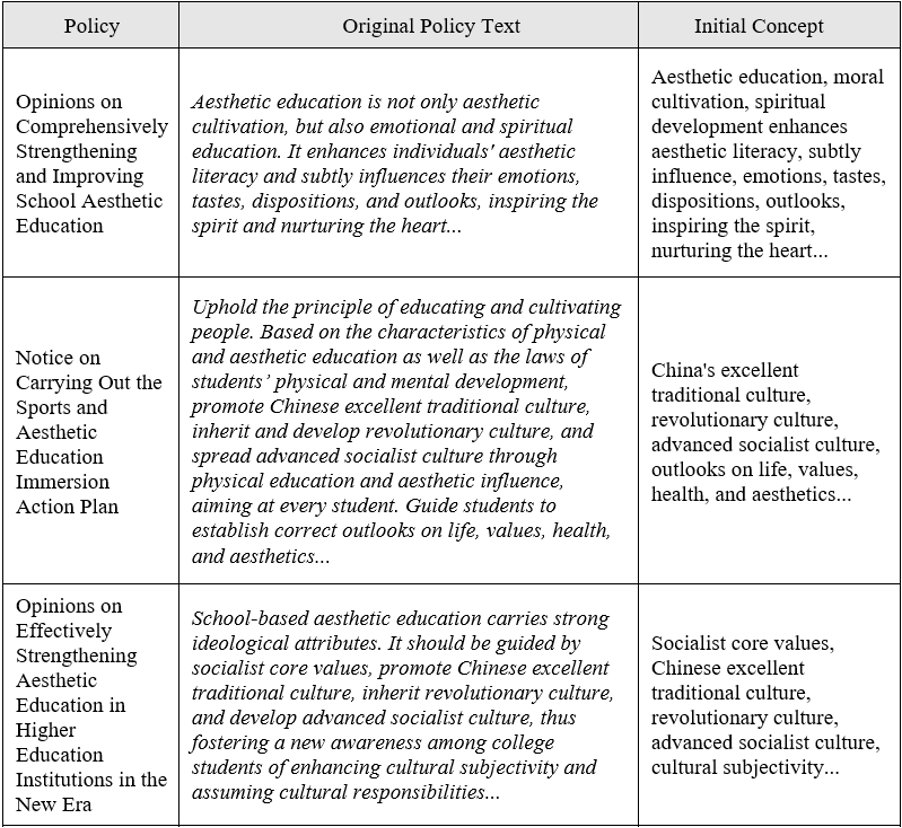
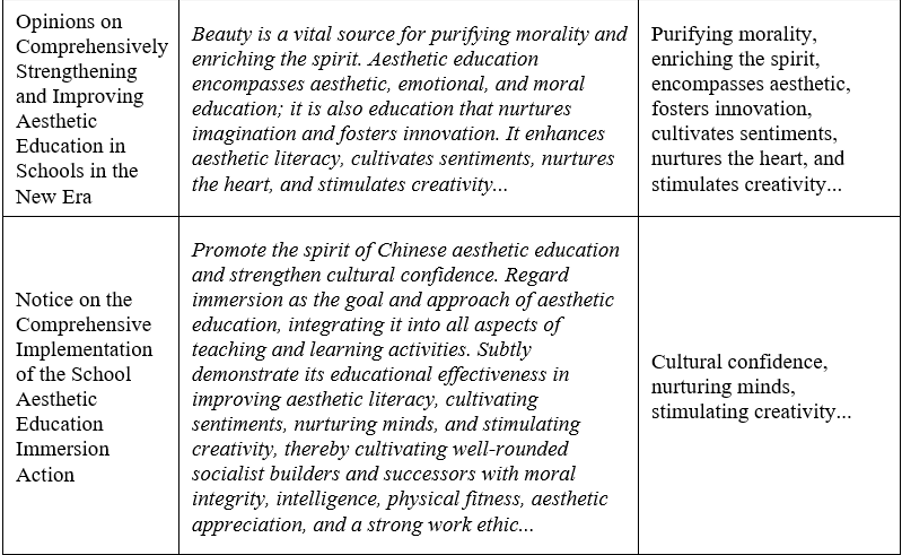
Analysis of Teacher Interviews
To explore the objectives of cultivating students' aesthetic literacy, semi-structured interviews were conducted with teachers from the Tourism Department at Zhuhai First Vocational School. The participants included four teachers from the department and one external teacher, assigned codes T1 to T5. Details of the interviews are provided in Table 2.
Teachers' backgrounds involve expertise in tourism and aesthetic education:
T1:Host of the Guangdong Province Model Principal Studio, research focus on “Virtue Integration”.
T2: Tea Art Instructor, teaching the course “Chinese Tea Art”.
T3: Deputy Director of the Tourism Department, Senior Lecturer, teaching the course “Hotel Services”.
T4: Pearl River Scholar, part-time master's supervisor at South China Normal University, research focus on wine tourism.
T5: Tea Art Instructor, teaching the course “Chinese Tea Art”.
After the interviews, the author compiled 24383 words of raw text. Initial concepts were identified from the interview text, as shown in Table 3, which displays some of the coding results.
Table 2
Interview Information
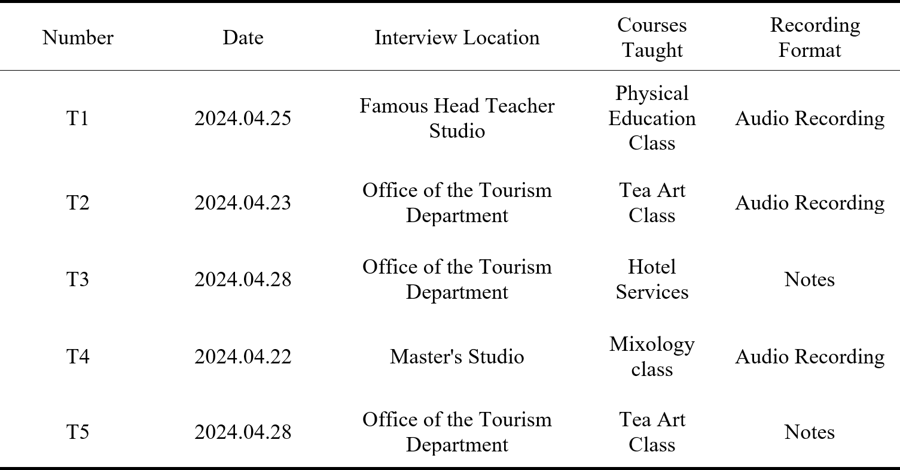
Table 3
Initial concepts from teacher interviews
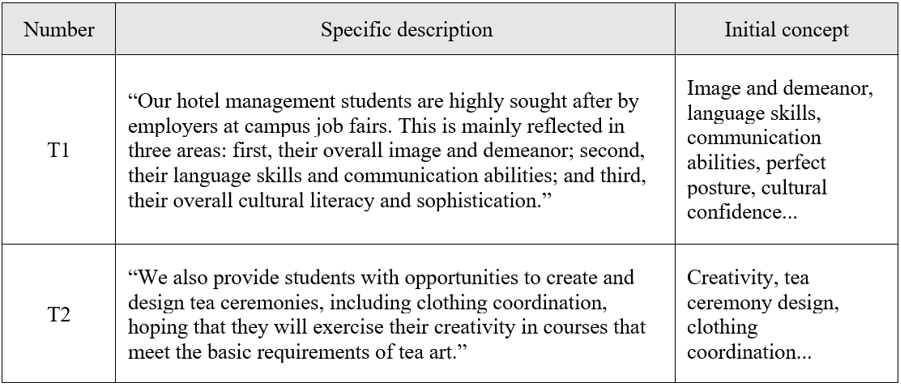
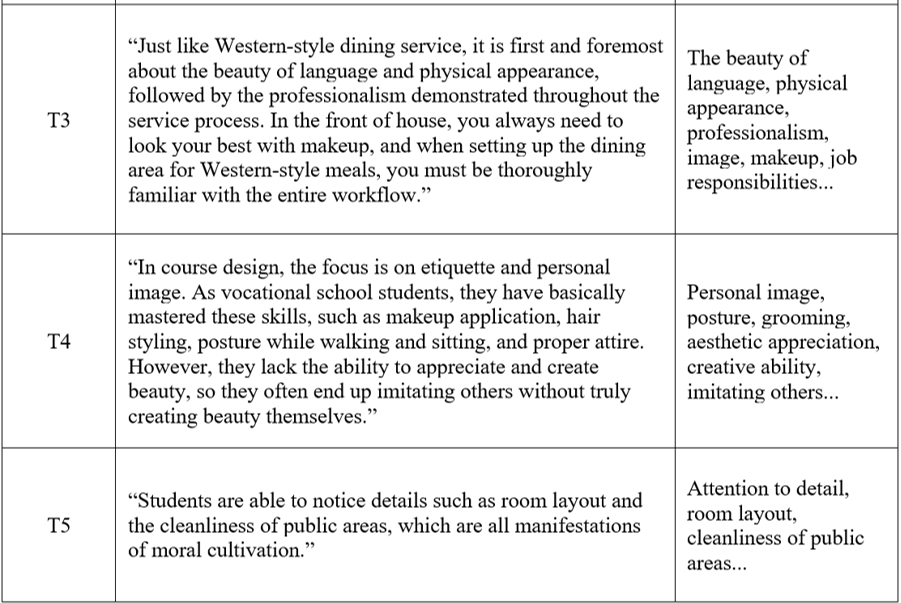
Aesthetic Literacy Objective Dimensions
A total of 121 initial concepts were extracted from the original texts of policy documents and teacher interviews. Considering the redundancy and overlap among the initial concepts, the author refined them to obtain 28 initial categories. To further explore the relationships between the initial categories, they were grouped into subcategories and main categories, ultimately yielding 10 subcategories and 4 main categories. The main categories include aesthetic knowledge, aesthetic ability, aesthetic awareness, and moral cultivation, as detailed in Table 4.
The logical connection among the four is manifested as a dynamically generated structural relationship. Aesthetic knowledge provides the cognitive foundation for the development of aesthetic abilities, while the practice of aesthetic abilities in turn feeds back into the iteration of knowledge. Aesthetic awareness determines how students select their focus within the complex knowledge system, and moral cultivation represents the stable professional competencies and moral qualities that students gradually develop throughout this process. The parallel arrangement of moral cultivation alongside aesthetic knowledge, aesthetic ability, and aesthetic awareness signifies that aesthetic education is not limited to the training of artistic skills, breaking through the previously fragmented state of aesthetic education and moral education.
Table 4
Categories of aesthetic literacy
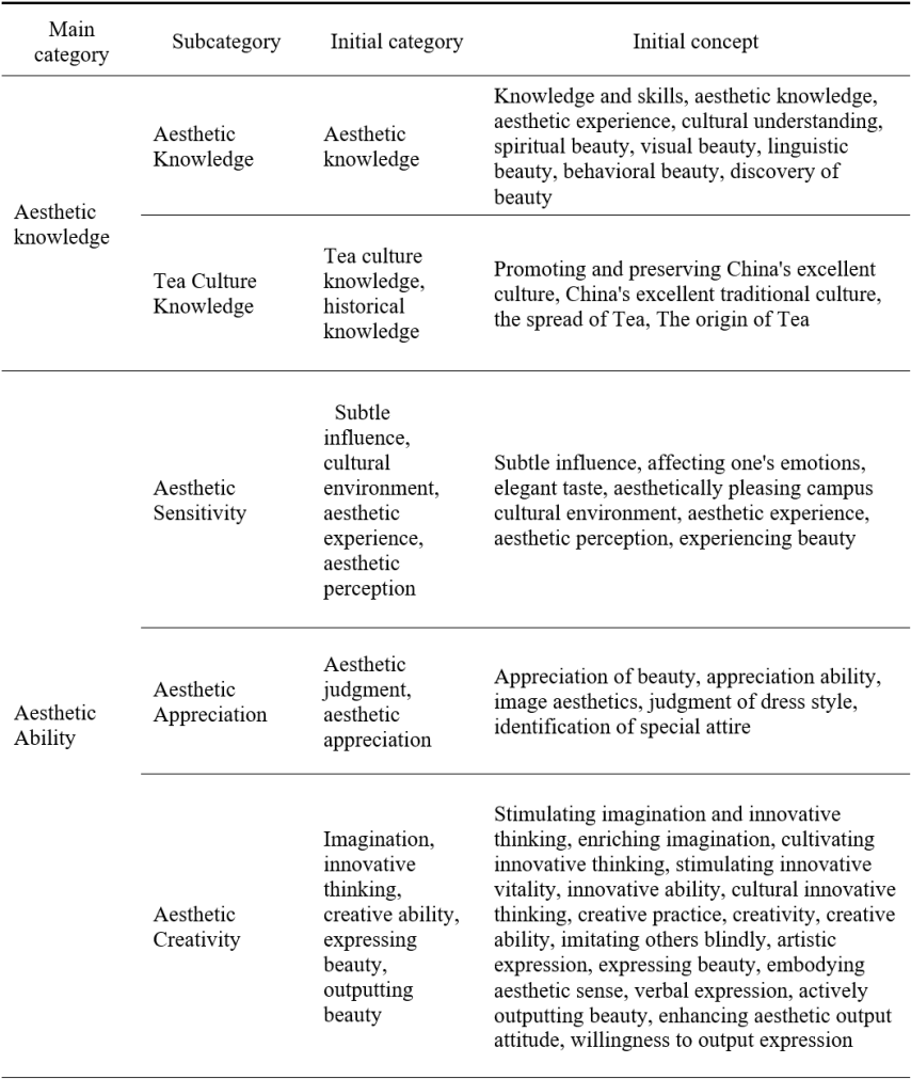

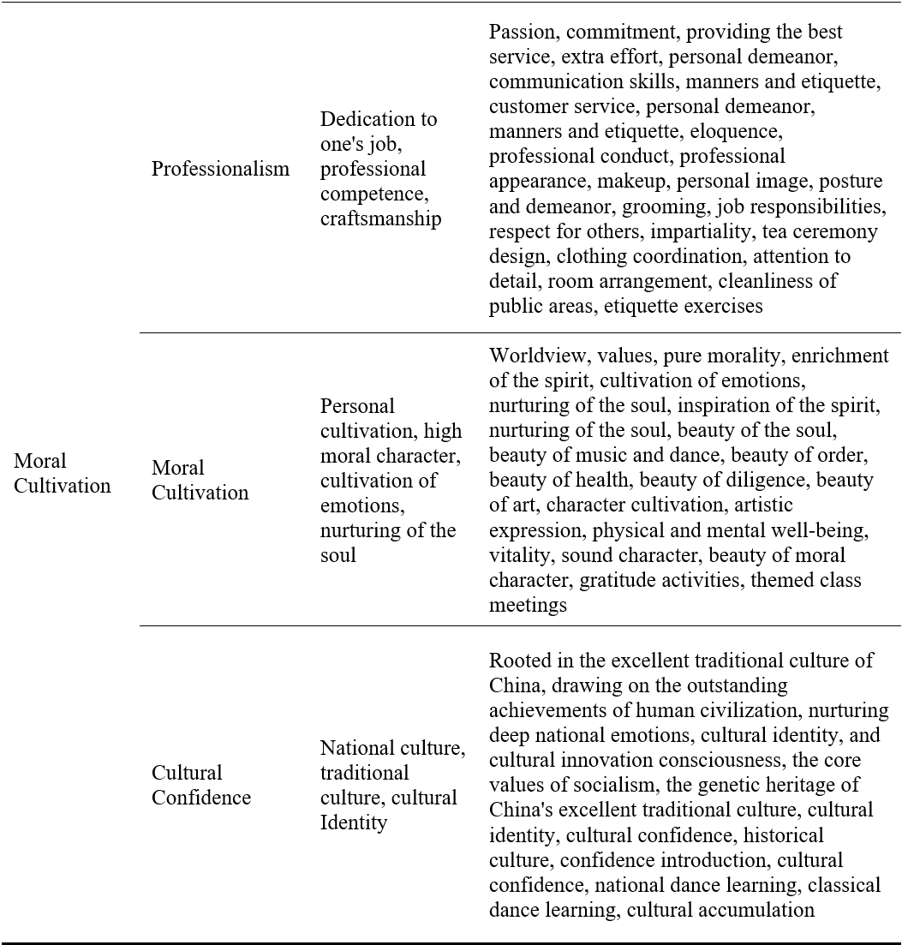
Aesthetic Literacy Objectives in the Tea Art Course
The vocational education course “Tea Art” incorporates rich aesthetic literacy objectives. Based on the “National Vocational Skills Standard for Tea Artisans (2018 Edition)” and the “14th Five-Year Plan” textbook “Tea Art Fundamentals”, this study uses the six elements of tea art as a basis for classification and summarizes the aesthetic literacy objectives of the vocational education course “Tea Art,” as shown in Table 5.
Table 5
Aesthetic Literacy Goals
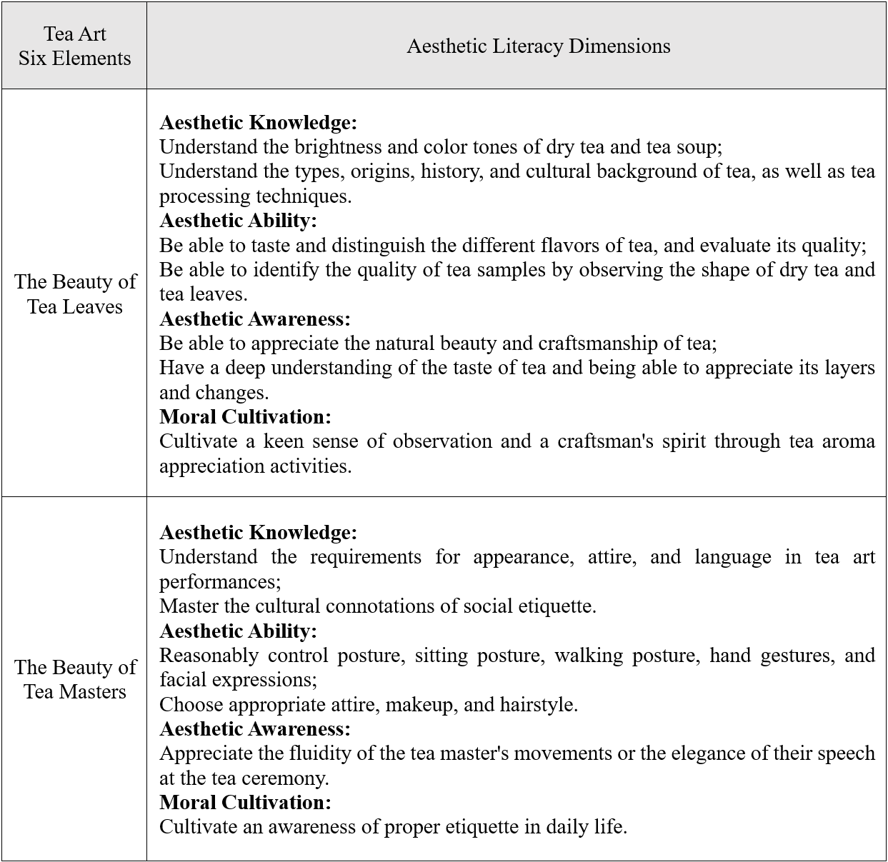
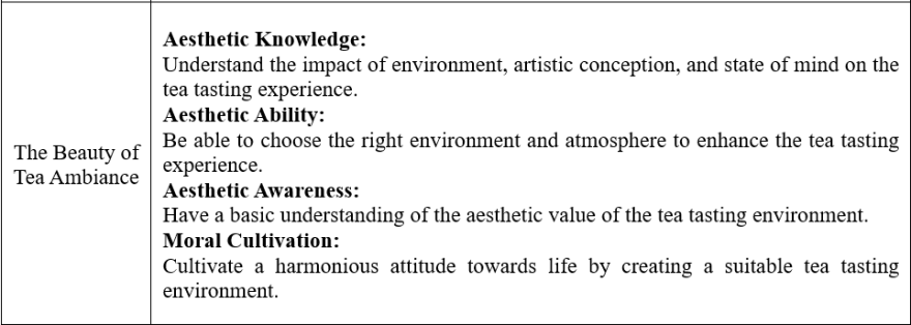
Situational Teaching Design Oriented Toward Cultivating Aesthetic Literacy
Teaching Design
A Model for Cultivating Aesthetic Literacy in Situational Teaching. This study reviewed Li Jilin's literature on the relationship between Situational Teaching methods and aesthetic literacy. By combining the types of situational teaching and the four characteristics of authenticity, emotion, beauty, and thought, a model for cultivating aesthetic literacy through situational teaching has been constructed, as shown in Figure 1. Situational teaching methods for cultivating aesthetic literacy can be divided into three major stages.
Figure 1
Model of Situational Teaching for Cultivating Students' Aesthetic Literacy
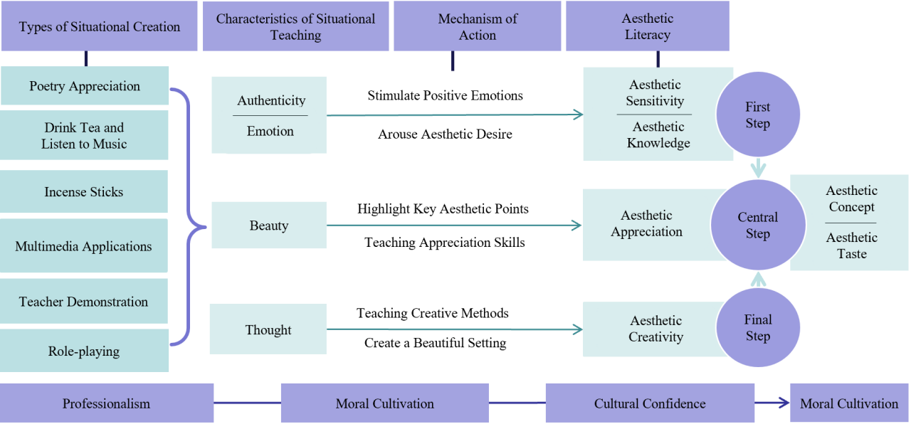
The first step is to focus on cultivating students' aesthetic sensitivity. Without the ability to perceive beauty, one cannot appreciate it, let alone create it. Therefore, cultivating students' ability to perceive beauty through its outward manifestations is the foundation of aesthetic education (Li, 2010). How can students be made to feel deeply involved in the learning process? First, the imagery must be vivid (authentic), visible, and audible, so that students can form a genuine sense of connection. Second, teachers should use sincere emotions to move students (emotion), reducing psychological distance and fostering emotional resonance, thereby achieving emotional engagement. This process enhances students' aesthetic perception. In the context, students develop positive emotions, which stimulate their aesthetic desires. This not only accelerates their understanding and internalization of knowledge but also provides a solid foundation for transforming learned knowledge into practical action.
The central step is to enhance students' aesthetic appreciation. To make the content of situational teaching richer and more in-depth, teachers need to start from the teaching objectives and carefully design each aesthetically pleasing situation (beauty) in the teaching process, ensuring that they all closely revolve around the teaching objectives. Teachers should highlight the key points of aesthetics, impart appreciation knowledge, and better guide students to deeply understand the teaching content, thereby enhancing their aesthetic appreciation.
The final step is to enhance students' aesthetic creativity. A broad and profound artistic conception can stimulate students' imagination (thought). Students can provide feedback on their imagination to teachers during the learning process. Teachers can then teach students creative methods based on their feedback, strive to create beautiful contexts for students, and engage in innovative practices to enhance students' aesthetic creativity.
From these three stages, it is evident that students' learning is not merely about acquiring knowledge but also involves cultural cultivation and emotional immersion (Li, 1997). Students gradually internalize what they have learned and experienced, enriching their spiritual world and forming relatively stable aesthetic views and tastes. The development of moral cultivation also depends on teachers' guidance and example. As cultural bridges and value guides, teachers integrate aesthetic education with moral education, enabling students to enhance their moral cultivation through subtle influence.
The teaching process of aesthetic literacy in situational teaching. In the overall structure of the teaching process, the three stages of pre-class situational preparation, in-class situational experience, and post-class situational extension are closely linked, together forming a complete chain of teaching processes, each of which plays an irreplaceable key role, as shown in Figure 2.
Pre-class situation preparation consists of three main parts: collaborative division of labor, post task, and create situation. Collaborative division of labor refers to students clarifying their tasks before class. Post task refers to teachers assigning specific tasks to students via the Learning Pass app, guiding them to engage in independent learning before class. Create situation refers to creating an aesthetically pleasing teaching scenario that facilitates students' acquisition and internalization of knowledge in class.
In-class situation experience includes six parts: stimulate, teach, practice, integrate, showcase and evaluate. Stimulation and introduction refers to teachers introducing course content in an interesting way at the beginning of class to stimulate students' positive emotions and arouse their aesthetic desires. Teaching refers to teachers highlighting aesthetic points and imparting appreciation knowledge during the explanation process. Practice guidance refers to students practicing according to the teacher's explanation and demonstration, with teachers providing guidance and promptly correcting incorrect operations. Integration involves students enhancing their cooperative skills through group role-playing. Showcase involves students demonstrating their aesthetic output through performances. Evaluation and summary involve teachers and students providing diverse feedback on the presented content and summarizing key aesthetic knowledge and skills.
Post-class situation extension includes three parts: assignment feedback, exhibiting works, and sharing. Assignment feedback refers to teachers providing targeted comments on students' homework. Exhibiting works involves showcasing students' work in campus cultural settings such as classroom cultural walls and bulletin boards to create an “aesthetic” atmosphere. Sharing refers to utilizing third-party platforms for learning exchanges with more people to broaden aesthetic horizons.
Figure 2
Teaching Process Design Diagram
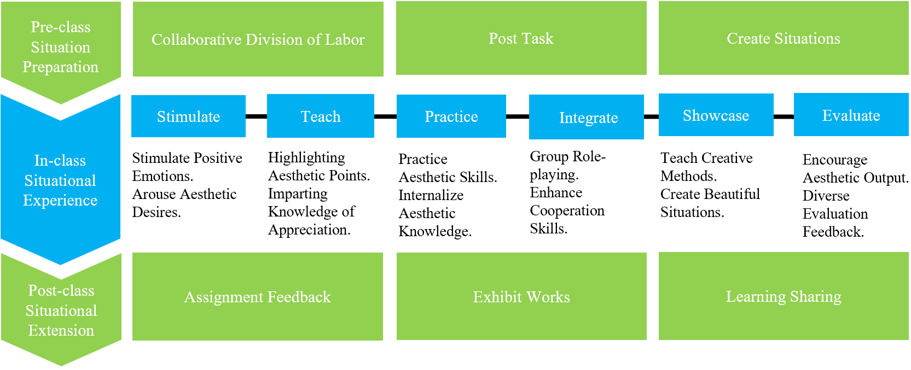
Teaching Implementation
The “Tea Art” course is a required professional course for the Tourism major at Zhuhai First Vocational School and a general elective course for the entire school. It is typically offered in the second year of vocational school and is equipped with a tea art training room for students to practice hands-on skills. This study focuses the instructional content on the final four class periods of this course, specifically Project 8 Task 4: Tea beverage mixing, and conducts two rounds of action research. The two rounds of action research were used to verify the effectiveness of the teaching models and processes in cultivating aesthetic literacy.
First round of action research. Class Information: The teaching content is creative fruit tea beverage mixing. The class time is 2024.06.07, 90 minutes.
Teaching Objectives: In Knowledge and Skills: Students will master the usage method of the cocktail shaker and the production process of mixed tea beverages. In Process and Methods: Students will experience the process from creative conception to practical production. In Emotion, Attitude, and Values: To cultivate students' interest in and respect for Chinese tea culture, and enhance cultural confidence. In Aesthetic Literacy: Students will understand the visual effects of different colors in mixed tea beverages and be able to create aesthetically pleasing mixed fruit tea beverages from aspects such as color coordination and flavor balance.
Key and Difficult Teaching Points: The key points are the usage method of the cocktail shaker, and color coordination and flavor balance in mixed tea beverage production. The difficult point is guiding students to create aesthetically pleasing mixed fruit tea beverages from aspects such as color coordination and flavor balance.
Second round of action research. Class Information: The teaching content is creative milk tea beverage mixing. The class time is 2024.06.14, 90 minutes.
Teaching Objectives: In Knowledge and Skills: Proficiently master the judgment methods for black tea infusion quality, including the tea sommelier evaluation method and the international milk-addition evaluation method. In Process and Methods: Review black tea evaluation methods and experience the aesthetic norms of tea art operations in practice. In Emotion, Attitude, and Values: Stimulate students' strong interest in tea culture and enhance cultural confidence. In Aesthetic Literacy: Guide students to explore and enhance aesthetic creativity.
Key and Difficult Teaching Points: The key points are enabling students to master the judgment methods for black tea infusion quality, explaining the specific methods from creative source to transformation, and improving students' aesthetic creativity. The difficult point is stimulating students' innovative thinking and enabling students to organically integrate cultural elements, personal creativity, and tea art aesthetics.
Implementation Results
Pre- and Post-Test Comparison. To verify the effectiveness of cultivating students' aesthetic qualities, questionnaires were distributed to students before and after the two rounds of action research. Forty-two evaluation forms were collected online. After matching the pre- and post-test data, the sample size was 41 people. The data analysis is shown in Table 8.
As shown in the table, prior to the teaching practice, the mean aesthetic knowledge score of the students was 3.89. After two rounds of teaching practice, the mean score was 4.51, representing a significant increase of 0.62. Tea culture knowledge increased by 0.51, with p < 0.05, indicating a significant difference. This suggests that the students' aesthetic knowledge has been effectively enhanced. In terms of aesthetic ability, aesthetic perception, aesthetic appreciation, and aesthetic creativity increased by 0.34, 0.63, and 0.61, respectively, with p < 0.05, indicating significant differences. This suggests that students' aesthetic abilities have improved. In terms of aesthetic awareness, aesthetic taste increased by 0.39, with p < 0.05. In terms of moral cultivation, professional spirit and cultural confidence increased by 0.53 and 0.39, respectively, with significant differences. However, students' aesthetic concepts and moral cultivation did not increase, with p > 0.05, indicating no significant differences.
Table 6
Results of paired sample T-tests
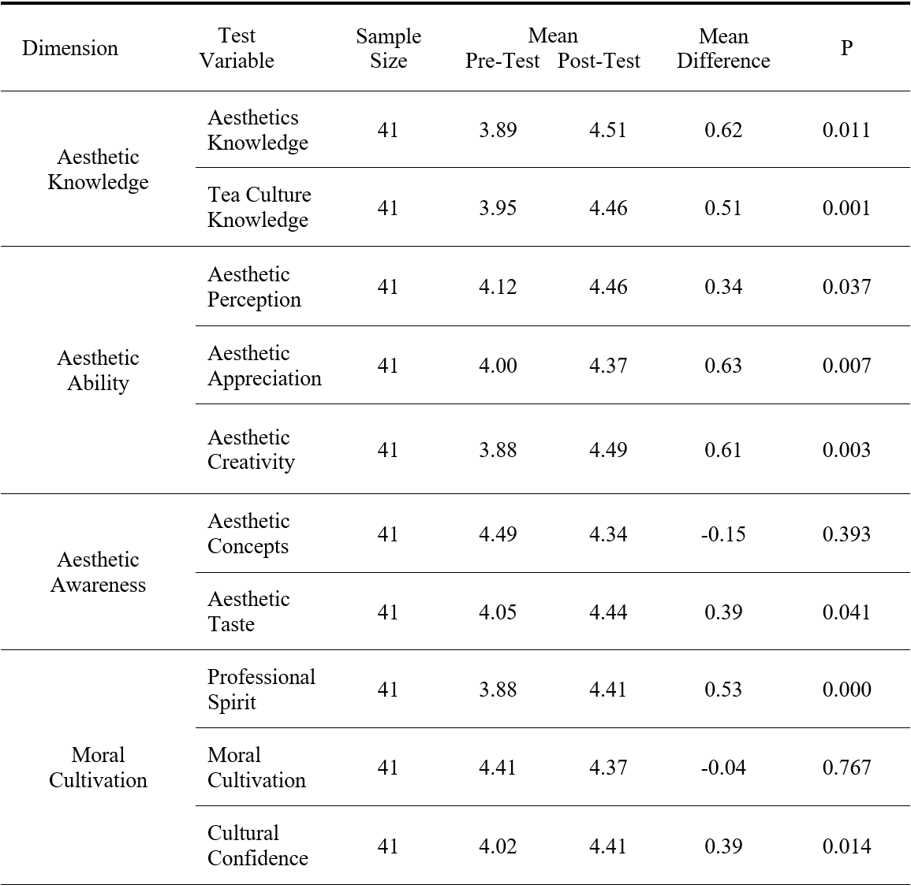
Practical Assessment Score Comparison. In both teaching practices, the same scoring sheet was used for the practical assessment, consisting of two scoring sheets: one for intergroup scoring and one for teacher scoring. The intergroup scoring sheet was out of 70 points, and the teacher scoring sheet was out of 100 points. By measuring the group score difference, the overall change in the aesthetic literacy of the group members was determined.
The groups with the largest score differences among teachers were Group 8 (10 points), Group 1 (9 points), and Group 9 (9 points). These three groups also made significant progress in peer evaluations between groups (with score differences of 9 points, 10 points, and 11 points). This indicates that these groups gained a deeper understanding and practical application of the aesthetic-related knowledge emphasized by the teacher in the “Tea Art” course during the second class. The groups with smaller differences in teacher scores were Group 2 (5 points), Group 4 (4 points), and Group 7 (5 points). The intergroup peer evaluation score differences for these three groups were 9 points, 3 points, and 3 points, respectively. All nine groups showed improvements in both intergroup peer evaluation and teacher evaluation scores, indicating that the use of situational teaching methods in the “Tea Art” course to cultivate students' aesthetic literacy is highly effective.
Table 7
Practical Assessment Score Comparison
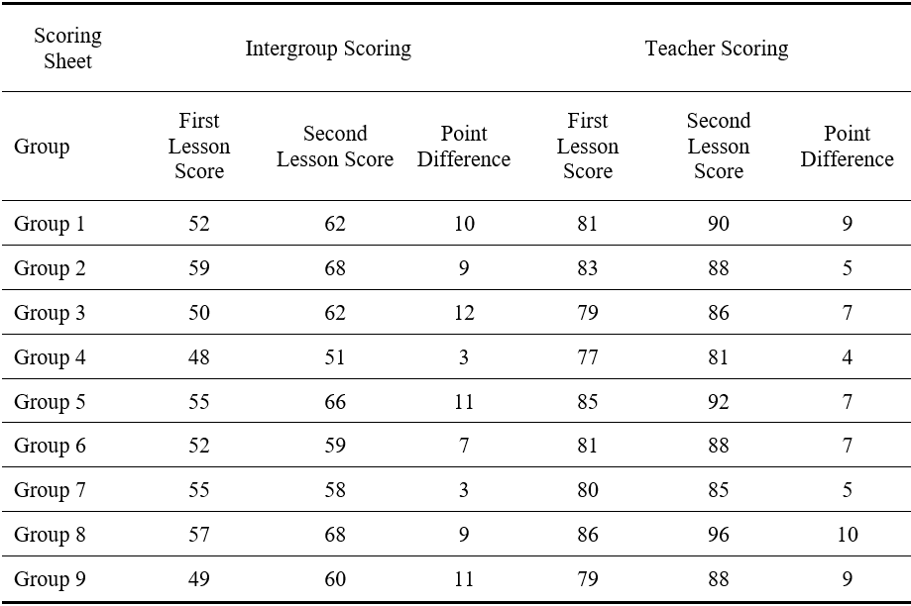
The groups with the largest score differences among teachers were Group 8 (10 points), Group 1 (9 points), and Group 9 (9 points). These three groups also made significant progress in peer evaluations between groups (with score differences of 9 points, 10 points, and 11 points). This indicates that these groups gained a deeper understanding and practical application of the aesthetic-related knowledge emphasized by the teacher in the “Tea Art” course during the second class. The groups with smaller differences in teacher scores were Group 2 (5 points), Group 4 (4 points), and Group 7 (5 points). The intergroup peer evaluation score differences for these three groups were 9 points, 3 points, and 3 points, respectively. All nine groups showed improvements in both intergroup peer evaluation and teacher evaluation scores, indicating that the use of situational teaching methods in the “Tea Art” course to cultivate students' aesthetic literacy is highly effective.
Teaching Optimization Recommendations.
In terms of Pre-class situation preparation. Systematically organize teaching materials. Teachers should prepare a list of materials for each group in advance and set up a supply of spare materials on the workbench to meet unexpected needs, ensuring the smooth running of the practical session.
Establish a group leader responsibility system. Group leaders should supervise group members in preparing materials, cultivating a sense of responsibility and teamwork habits.
In terms of In-class situation experience. Enhance students' emotional experiences. Teachers should use hand gestures to illustrate key operational points during explanations and use eye contact to identify signs of confusion among students. During practical sessions, teachers should increase patrols, immediately use hand gestures to point out minor errors, pause for collective demonstrations when common issues arise, and immediately praise innovative approaches.
Reasonably adjust each stage of the teaching process. Teachers should increase the time allocated for group cooperative exploration, invite tea art instructors into the classroom to create a dual-teacher classroom, and ensure that teaching content meets both curriculum standards and industry demands.
In post-class Post-class situation extension. Set up a “mobile aesthetics wall” in the classroom, rotating group works weekly, with QR codes linking to detailed explanatory videos, and interacting with other works on Xiaohongshu.
Regularly organize students to visit industrial bases for on-site inspections, transforming industry-standard aesthetic criteria into learning outcomes.
Conclusions and Prospects
Research Conclusions
This study investigates the teaching design and application of situational teaching methods in the cultivation of students' aesthetic literacy in vocational school tea art courses. After exploring the cultivation model and teaching process of aesthetic literacy under situational teaching, two rounds of action research were conducted to investigate the teaching effectiveness of situational teaching methods in cultivating students' aesthetic literacy. The following conclusions were drawn:
First, the aesthetic literacy assessment scale was improved. Previous studies primarily borrowed Du Wei's proposed structure of aesthetic literacy for questionnaire design, which included three dimensions: aesthetic knowledge, aesthetic ability, and aesthetic awareness. This study found that China's aesthetic education policies frequently mention expressions related to moral cultivation. Using NVivo to analyze aesthetic education policy texts and teacher interview texts, the dimension of moral cultivation was added, forming four dimensions: aesthetic knowledge, aesthetic ability, aesthetic awareness, moral cultivation. These four dimensions are further broken down into ten sub-dimensions: aesthetic knowledge, tea culture knowledge, aesthetic sensitivity, aesthetic appreciation, aesthetic creativity, aesthetic concepts, aesthetic tastes, professionalism, professional spirit, moral cultivation, and cultural confidence. Second, the situational teaching method is practical for designing teaching processes aimed at enhancing students' aesthetic literacy. By reviewing relevant literature by Li Jilin and combining the unique advantages of situational teaching with different types of situational creation, a model and teaching process for cultivating aesthetic literacy through situational teaching were established. After two rounds of action research in teaching design and implementation, it was verified that this teaching process provides clear design guidelines for teaching and is highly practical.
Third, the application of situational teaching methods in tea art courses has a significant effect on enhancing students' aesthetic literacy. Through pre- and post-survey comparisons and comparisons of students' practical assessment scores across two rounds, it was found that students achieved improvements in all four dimensions: aesthetic knowledge, aesthetic ability, aesthetic awareness, and moral cultivation.
Research Prospects
This paper validates the teaching effectiveness of situational teaching in cultivating students' aesthetic literacy, but there are still areas for further research.
First, the study only used one class as the research subject, resulting in a small sample size. In future research, it is necessary to conduct teaching practices in multiple classes across several vocational schools. Second, teaching outcomes do not show significant changes in the short term. In future research, it is essential to increase the duration of teaching practices, with at least half a semester dedicated to teaching design and implementation. Third, the scale development methodology requires refinement. In the preliminary phase of this study, NVIVO was used to conduct three-level coding of aesthetic education policy texts and teacher interview texts, resulting in the preliminary construction of four dimensions of the aesthetic literacy scale. However, the singularity of qualitative coding may limit the validity of dimension construction. Future research could employ the Delphi method to conduct three rounds of expert consultations to refine the indicator system, ultimately developing an assessment tool that combines theoretical depth with statistical reliability.
Declaration of competing interest
The authors declared no potential conflicts of interest with respect to the research, authorship, and/or publication of this article.



